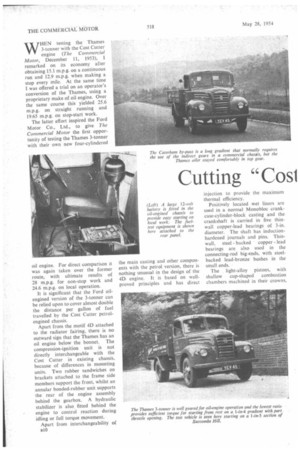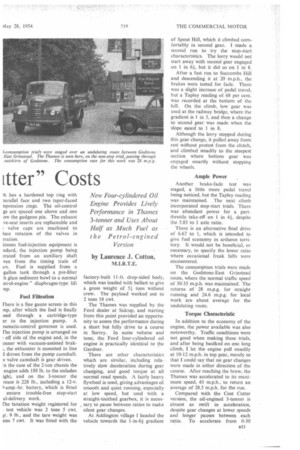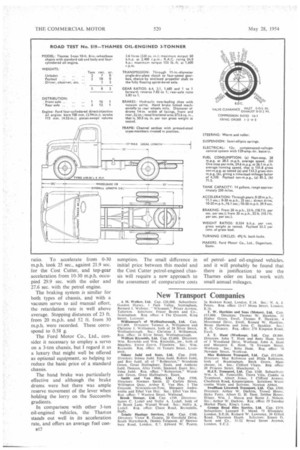Cutting "Cosi itter" Costs
Page 44

Page 45

Page 46

If you've noticed an error in this article please click here to report it so we can fix it.
New Four-cylindered Oil Engine Provides Lively Performance in Thames 3-tonner and Uses About Half as Much Fuel as the Petrol-engined Version by Laurence J. Cotton,
M.1.R.T.E. WHEN testing the Thames 3-tonner with the Cost Cutter engine (The Conitnercial Motor, December 11, 1953), I remarked on its economy after obtaining 15.1 m.p.g. on a continuous run and 12.9 m.p.g. when making a stop every mile. At the same time
was offered a trial on an operator's conversion of the Thames, using a proprietary make of oil engine. Over the same course this yielded 25.6 m.p.g. on straight running and 19.65 m.p.g. on stop-start work.
The latter effort inspired the Ford Motor Co., Ltd., to give The Commercial Motor the first opportunity of testing the Thames 3-tonner with their own new four-cylindered
oil engine. For direct comparison it was again taken over the former route, with ultimate results of 28 m.p.g, for non-stop work and 24.6 m.p.g. on local operation.
It is significant that the Ford oilengined version of the 3-tonner can be relied upon to cover almost double the distance per gallon of fuel travelled by the Cost Cutter petrolengined chassis.
Apart from the motif 4D attached to the radiator fairing, there is no outward sign that the Thames has an oil engine below the bonnet. The compression-ignition unit is not directly interchangeable with the Cost Cutter in existing chassis, because of differences in mounting units. Two rubber sandwiches on brackets attached to the frame side members support the front, whilst an annular bonded-rubber unit supports the rear of the engine assembly behind the gearbox. A hydraulic stabilizer is also fitted behind the engine to control reaction during idling or full torque movement.
Apart from interchangeability of the main casting and other components with the petrol version, there is nothing unusual in the design of the 4D engine. It is based on wellproved principles and has direct injection to provide the maximum thermal efficiency.
Positively located wet liners are used in a normal Monobloc crankcase-cylinder-block casting and the crankshaft is carried in five thinwall copper-lead bearings of 3-in. diameter. The shaft has inductionhardened journals and pins. Thinwall, steel backed copper lead bearings are also used in the connecting-rod big-ends, with steelbacked lead-bronze bushes in the small ends.
The light-alloy pistons, with shallow cup-shaped combustion chambers machined in their crowns,
:h has a hardened top ring with 3arallel face and two taper-faced npression rings. The oil-control gs are spaced one above and one ow the gudgeon pin. The exhaust ve-scat inserts are replaceable and
valve caps are machined to luce rotation of the valves in !ration.
iimms fuel-injection equipment is ndard, the injection pump being !rated from an auxiliary shaft ven from the timing train of irs. Fuel is supplied from a gallon tank through a pre-filter h glass sediment bowl to a normal etrol-engine " diaphragm-type lift np.
Fuel Filtration
[here is a fine gauze screen in this rip, after which the fuel is finally ised through a cartridge-type er to the injection pump. A !umatic-control governor is used. the injection pump is arranged on off side of the engine and, in the onner with vacuum-assisted brak:, the exhauster is mounted in line driven from the pump camshaft. e valve camshaft is gear driven. n the case of the 2-ton chassis the engine adds 188 lb. to the unladen ight, and on the 3-tonner the tease is 228 lb., including a 12-v.
■ -amp.-hr. battery, which is fitted ensure trouble-free stop-start al-delivery work.
Ile taxation weight registered for test vehicle was 2 tons 5 cwt. jr. 9 lb., and the tare weight was ons 7 cwt. It was fitted with the factory-built 11-ft. drop-sided body, which was loaded with ballast to give a gross weight of 54 tons without crew. The payload worked out to 2 tons 18 cwt.
The Thames was supplied by the Ford dealer at Sidcup, and starting from this point provided an opportunity to assess the performance during a short but hilly drive to a course in Surrey.. In noise volume and tone, the Ford four-cylindered oil engine is practically identical to the Gardner, There are other characteristics which are similar, including relatively slow deceleration during gear changing, and good torque at all normal road speeds. A fairly heavy flywheel is used, giving advantages of smooth and quiet running, especially at low speed, but used with a straight-toothed gearbox, it is necessary to pause between ratios to make silent gear changes.
At Addington village I headed the vehicle towards the 1-in-6f gradient of Spout Hill, which it climbed comfortably in second gear. I made a second run to try the stop-start characteristics. The lorry would not start away with second gear engaged on 1 in 64, but it did so on 1 in 8.
After a fast run to Succombs Hill and descending it at 20 m.p.h., the brakes were tested for fade. There was a slight increase of pedal travel, but a Tapley reading of 68 per cent. was recorded at the bottom of the hill. On the climb, low gear was used at the railway bridge, where the gradient is 1 in 5, and then a change to second gear was made when the slope eased to 1 in 8: Although the lorry stopped during this gear change, it pulled away from rest without protest from the clutch, and climbed steadily to the steepest section where bottom gear was engaged smartly without stopping the wheels.
Ample Power _ Another brake-fade test was staged, a little more pedal travel being noticed, but the Tapley reading was maintained. The next climb incorporated stop-start trials. There was abundant power for a partthrottle take-off on 1 in 44, despite the 5.83 to 1 axle ratio.
There is an alternative final drive of 6.67 to 1, which is intended to give fuel economy in arduous territory. It would not be beneficial, or necessary, to specify the lower ratio where occasional freak hills were encountered.
The consumption trials were made on the Godstone-East Grinstead route, where the normal traffic speed of 30-35 m.p.h. was maintained: The returns of 28 m.p.g. for straight running and 24.6 m.p.g. for local work are about average for the undulating route.
Torque Characteristic
In addition to the economy of the engine, the power available was also noteworthy. Traffic conditions were not good when making these trials, and after being baulked on one long climb, I let the engine pull steadily at 10-12 m.p.h. in top gear, merely so that I could say that no gear changes were made in either direction of the course. After reaching the brow, the Thames was accelerated to its maximum speed, 43 m.p.h., to return an average of 28.5 m.p.h. for the run.
Compared with the Cost Cutter version, the oil-engined 3-tonner is almost as swift in acceleration, despite gear changes at lower speeds and longer pauses between each ratio. To accelerate from 0-30 ratio. To accelerate from 0-30 m.p.h. took 25 sec., against 21.9 sec. for the Cost Cutter, and top-gear acceleration from 10-30 m.p.h. occupied 29.9 sec. with the oiler and 27.6 sec. with the petrol engine.
The braking system is similar for both types of chassis, and with a vacuum servo to aid manual effort, the retardation rate is well above average. Stopping distances of 23 ft. from 20 m.p.h. and 52 ft. from 30 m.p.h. were recorded. These correspond to 0.58 g.
The Ford Motor Co., Ltd., consider it necessary to employ a servo on a 3-ton chassis, but I regard it as a luxury that might well be offered as optional equipment, so helping to reduce the basic price of a standard chassis.
The hand brake was particularly effective and although the brake drums were hot there was ample reserve movement of the lever when holding the lorry on the Succombs gradients.
In comparison with other 3-ton oil-engined vehicles, the Thames stands out well in its acceleration rate, and offers an average fuel con al 2 sumption. The small difference in initial price between this model and the Cost Cutter petrol-engined chassis will require a new approach to the assessment of comparative costs of petroland oil-engined vehicles, and it will probably be found that there is justification to use the Thames oiler on local work with small annual mileages.




































































































